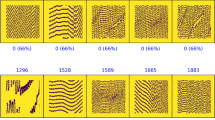Abstract
Recent reactor antineutrino experiments have observed that the neutrino spectrum changes with the reactor core evolution and that the individual fissile isotope antineutrino spectra can be decomposed from the evolving data, providing valuable information for the reactor model and data inconsistent problems. We propose a machine learning method by building a convolutional neural network based on a virtual experiment with a typical short-baseline reactor antineutrino experiment configuration: by utilizing the reactor evolution information, the major fissile isotope spectra are correctly extracted, and the uncertainties are evaluated using the Monte Carlo method. Validation tests show that the method is unbiased and introduces tiny extra uncertainties.





Similar content being viewed by others
Data Availability
The data that support the findings of this study are openly available upon request in Science Data Bank at https://doi.org/10.57760/sciencedb.j00186.00075 and https://cstr.cn/31253.11.sciencedb.j00186.00075
References
Th.A. Mueller, D. Lhuillier, M. Fallot et al., Improved predictions of reactor antineutrino spectra. Phys. Rev. C 83, 054615 (2011). https://doi.org/10.1103/PhysRevC.83.054615
P. Huber, Determination of antineutrino spectra from nuclear reactors. Phys. Rev. C 84, 024617 (2011). https://doi.org/10.1103/PhysRevC.84.024617
G. Mention, M. Fechner, Th. Lasserre et al., Reactor antineutrino anomaly. Phys. Rev. D 83, 073006 (2011). https://doi.org/10.1103/PhysRevD.83.073006
Y. Abe, J.C. dos Anjos, J.C. Barriere et al., Improved measurements of the neutrino mixing angle \(\theta _{13}\) with the Double Chooz detector. J. High Energy Phys. 2014, 86 (2014). https://doi.org/10.1007/JHEP10(2014)086
S.H. Seo et al., (RENO Collaboration), New results from RENO and the 5 MeV excess. AIP Conf. Proc. 1666, 080002 (2015). https://doi.org/10.1063/1.4915563
F.P. An, A.B. Balantekin, H.R. Band et al., (Daya Bay Collaboration), Measurement of the reactor antineutrino flux and spectrum at Daya Bay. Phys. Rev. Lett. 116, 061801 (2016). https://doi.org/10.1103/PhysRevLett.116.061801
F.P. An, A.B. Balantekin, H.R. Band et al., (Daya Bay Collaboration), Evolution of the reactor antineutrino flux and spectrum at Daya Bay. Phys. Rev. Lett. 118, 251801 (2017). https://doi.org/10.1103/PhysRevLett.118.251801
J. Ashenfelter, A.B. Balantekin, H.R. Band et al., (PROSPECT Collaboration), Measurement of the antineutrino spectrum from \(^{235}{\rm U }\) fission at HFIR with PROSPECT. Phys. Rev. Lett. 122, 251801 (2019). https://doi.org/10.1103/PhysRevLett.122.251801
M. Estienne, M. Fallot, A. Algora et al., Updated summation model: an improved agreement with the Daya Bay antineutrino fluxes. Phys. Rev. Lett. 123, 022502 (2019). https://doi.org/10.1103/PhysRevLett.123.022502
D. Adey, F.P. An, A.B. Balantekin et al., (Daya Bay Collaboration), Extraction of the \(^{235}{\rm U }\) and \(^{239}{\rm Pu}\) antineutrino spectra at Daya Bay. Phys. Rev. Lett. 123, 111801 (2019). https://doi.org/10.1103/PhysRevLett.123.111801
Technical meeting on nuclear data for antineutrino spectra and their applications, 23–26 Apr 2019, Vienna, Austria. https://www.iaea.org/events/evt1703666
N.S. Bowden, J.M. Link, W. Wang, Report of the topical group on neutrino applications for Snowmass (2021). https://doi.org/10.48550/arXiv.2209.07483
O. Akindele, N. Bowden, R. Carr et al., Nu tools: exploring practical roles for neutrinos in nuclear energy and security. https://doi.org/10.48550/arXiv.2112.12593
D. Bhatt, C. Patel, H. Talsania et al., CNN variants for computer vision: history, architecture, application, challenges and future scope. Electronics 10, 2470 (2021). https://doi.org/10.3390/electronics10202470
Y.T. Luo, H. Du, Y.M. Yan, MeshCNN-based BREP to CSG conversion algorithm for 3D CAD models and its application. Nucl. Sci. Tech. 33, 74 (2022). https://doi.org/10.1007/s41365-022-01063-5
X.Y. Guo, L. Zhang, Y.X. Xing, Study on analytical noise propagation in convolutional neural network methods used in computed tomography imaging. Nucl. Sci. Tech. 33, 77 (2022). https://doi.org/10.1007/s41365-022-01057-3
L.Y. Zhou, H. Zha, J.R. Shi et al., A non-invasive diagnostic method of cavity detuning based on a convolutional neural network. Nucl. Sci. Tech. 33, 94 (2022). https://doi.org/10.1007/s41365-022-01069-z
D. Ribli, B.Á. Pataki, J.M. Zorrilla Matilla et al., Weak lensing cosmology with convolutional neural networks on noisy data. Mon. Not. R. Astron. Soc. 490, 1843 (2019). https://doi.org/10.1093/mnras/stz2610
C.M. Bishop, N.M. Nasser, Pattern recognition and machine learning, Vol. 4. No. 4. (New York: springer, 2006)
F.P. An, A.B. Balantekin, H.R. Band et al., (Daya Bay Collaboration), Improved measurement of the reactor antineutrino flux and spectrum at Daya Bay. Chin. Phys. C 41, 013002 (2017). https://doi.org/10.1088/1674-1137/41/1/013002
X.B. Ma, W.L. Zhong, L.Z. Wang et al., Improved calculation of the energy release in neutron-induced fission. Phys. Rev. C 88, 014605 (2013). https://doi.org/10.1103/PhysRevC.88.014605
J.Y. Shi, Q.L. Huang, L. Wang et al. (2022) Distributed data processing platform of national high energy physics data center. Front. Data Comput. 4, 97. https://doi.org/10.11871/jfdc.issn.2096-742X.2022.01.008(in Chinese)
D.P. Kingma, J. Ba, Adam: a method for stochastic optimization. In: Proceedings of the 3rd International Conference on Learning Representations (ICLR 2015). https://www.iclr.cc/archive/www/2015.html
S. Ruder, An overview of gradient descent optimization algorithms. https://doi.org/10.48550/arXiv.1609.04747
Acknowledgements
The authors would like to thank Prof. Zhi-Bing Li (School of Physics, Sun Yat-sen University) for useful discussion during the course of this research.
Author information
Authors and Affiliations
Contributions
All authors contributed to the study conception and design. Material preparation, data collection and analysis were performed by Yu-Da Zeng, guided by Feng-Peng An and Wei Wang. The first draft of the manuscript was written by Yu-Da Zeng, Feng-Peng An and Wei Wang, and all authors commented on previous versions of the manuscript. All authors read and approved the final manuscript.
Corresponding author
Ethics declarations
Conflict of interest
The authors declare that they have no competing interests.
Additional information
This work was supported by the National Natural Science Foundation of China (Nos. 11675273 and 12075087) and the Strategic Priority Research Program of the Chinese Academy of Sciences (No. XDA10011102).
Rights and permissions
Springer Nature or its licensor (e.g. a society or other partner) holds exclusive rights to this article under a publishing agreement with the author(s) or other rightsholder(s); author self-archiving of the accepted manuscript version of this article is solely governed by the terms of such publishing agreement and applicable law.
About this article
Cite this article
Zeng, YD., Wang, J., Zhao, R. et al. Decomposition of fissile isotope antineutrino spectra using convolutional neural network. NUCL SCI TECH 34, 79 (2023). https://doi.org/10.1007/s41365-023-01229-9
Received:
Revised:
Accepted:
Published:
DOI: https://doi.org/10.1007/s41365-023-01229-9




